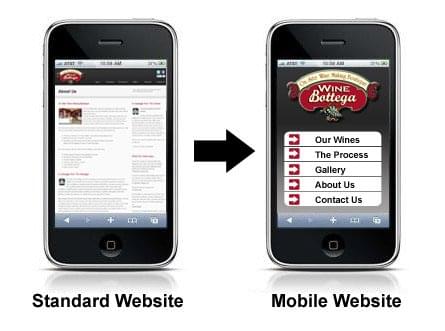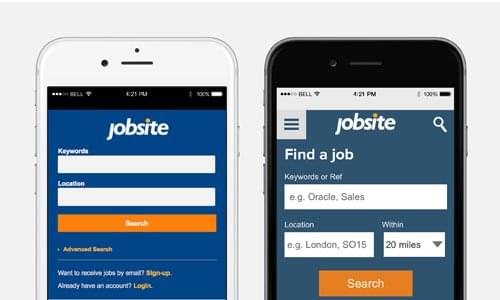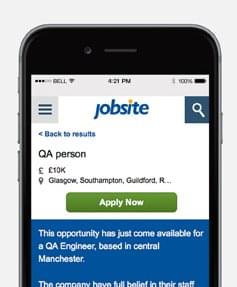The ULTIMATE Recruiter's Guide to Mobile for 2015

Mobile.
It’s a little word that means big things and big change, particularly within the recruitment industry. Various blog posts, infographics and reports have attempted to cover the topic in detail over the past year in a bid to demystify mobile for recruiters and get them on board, but few have managed to really put the importance of mobile technology for recruiters into context. Sure, most recruiters know mobile is important, but a massive 59% of them still currently invest nothing in mobile career sites.
Well, we’re here to change that. THIS is the ultimate recruiter’s guide to mobile the Social Talent way. There ain’t no alternative agendas here, just the most up-to-date facts, the most relevant figures, the most important reasons why you should be planning your mobile recruiting strategy, and the most practical guides for how to create your mobile recruiting strategy in 2015.
Mobile: The Facts Recruiters Need to Know
Mobile is no longer just an up and coming technology to be thought about in future terms. It’s here, it’s now and it’s happening at a rate of knots. The technology has and continues to change everything about how people interact, how they communicate and how they consume information. People are now managing their lives on their smartphones. Work and life are integrating. And agility, on your part, is critical to ensuring you don’t get left behind. 1.75 BILLION people now have a smartphone (that’s a quarter of the earth’s entire population), and by 2015 more people will have access to the internet on a mobile device than on a desktop computer.
-
Mobile is Changing Job Search
 3 in 5 job seekers (60%) are now using mobile devices to search for jobs. That’s 3 people in 5. And of them, 68% are searching for jobs once a week and 30% are searching more than once a day. Not only that, but the number of job searches from mobile devices doubles each year! Peak times for job search are also changing. On desktops, most job searches take place at 9AM. Mobile usage now peaks after office hours at 8PM and is more consistent throughout the day.
3 in 5 job seekers (60%) are now using mobile devices to search for jobs. That’s 3 people in 5. And of them, 68% are searching for jobs once a week and 30% are searching more than once a day. Not only that, but the number of job searches from mobile devices doubles each year! Peak times for job search are also changing. On desktops, most job searches take place at 9AM. Mobile usage now peaks after office hours at 8PM and is more consistent throughout the day.
-
Mobile is Changing the Application Process
51% or 1 in 2 job applications submitted on Indeed.com (the world’s largest job site) are submitted via mobile and a total of 200,000 applications are completed on the site every single day. That’s 100,000 mobile applications on one job site alone on a daily basis. Globally, 70% of job seekers desire the ability to apply for jobs via their mobile device. However, 60& of applicants will be put off applying for a mobile via mobile if there are tech hurdles to overcome, 55% will be put off if they are unable to upload a CV via mobile and 44% will be put off if there is no way to follow up on their application via mobile.
-
Mobile Job Boards are Taking Over
 Nearly 1 in 3 job seekers prefer the mobile versions of job boards, claiming they’re cleaner looking, easier to navigate and more user friendly. Half of all job searches on Indeed.com are now carried out on mobile devices. And of them, 82% are done on mobile phones and 18% are done using tablets. 54% of these job seekers are using iOS devices, while 46% are using Android.
Nearly 1 in 3 job seekers prefer the mobile versions of job boards, claiming they’re cleaner looking, easier to navigate and more user friendly. Half of all job searches on Indeed.com are now carried out on mobile devices. And of them, 82% are done on mobile phones and 18% are done using tablets. 54% of these job seekers are using iOS devices, while 46% are using Android.
-
Mobile is the Secret Key to Passive Candidates
While 45% of active candidates have applied for a job via mobile and 43% have uploaded their CV to a mobile job site, 21% of passive candidates have also APPLIED for a job via mobile and 21% have also uploaded their CV to a mobile job site. But perhaps most interesting of all is that while 72% of active job seekers have visited a careers site on their mobile device, a whopping 62% of passive candidates (i.e. this who claim they’re not actively looking for a new opportunity) have visited a careers site via their mobile.
-
Mobile is Giving Recruiters an Advantage
14% of recruiters using m obile platforms have seen a significant improvement in their time to hire. 19% have found the quality of their hires has improved from using mobile platforms. And 10% feel using mobile platforms has improved the quantity of referrals they receive and as every recruiter must know at this stage, referrals are a recruiter’s number one source of hires.
obile platforms have seen a significant improvement in their time to hire. 19% have found the quality of their hires has improved from using mobile platforms. And 10% feel using mobile platforms has improved the quantity of referrals they receive and as every recruiter must know at this stage, referrals are a recruiter’s number one source of hires.
-
Mobile Websites will be Ranked Higher by Google
Still not convinced about the power and influence of mobile? Well, would you change your mind if we told you that search engine giant, Google, have been huge advocates of mobile technology for years and that they have publicly stated their intent to make mobile-friendly websites standout on their search results (a practice that may lead to a new ranking factor)? Thought so!
How to: Create the Perfect Mobile Careers Site
If you have the chance to impress 72% of active job seekers and 62% of the people who think they’re not even in the market for a job, bloody well take it! And the best way to do so is by creating the perfect mobile careers site for them to use. How do you do that? Well, you do it in two ways:
- by ensuring the navigation on your careers site is optimised for mobile, and
- by ensuring the only the content that appears on the site is the content the user wants to see
With regards to optimised navigation, Google have stated that a website should offer the same user experience regardless of the device used by the viewer. As a result, their CEO and co-founder, Larry Page, officially endorses responsive design as the preferred method of building mobile-friendly websites. Responsive design is a web design approach aimed at crafting sites to provide an optimal viewing experience – easy reading and navigation without the need for the user to resize, pan or scroll excessively – across a wide range of devices. Put it this way, a standard website on a mobile device provides a poor user experience: the fonts are too small, there’s an overwhelming amount of information on one screen, and it’s very difficult to navigate (as illustrated below).

Credit: marsmediadesign.com
So unless the standard website is the only source of information the user is seeking (and with a careers site, it definitely isn’t), they will definitely bounce and choose a mobile-friendly website to visit. Meaning you just missed out on a potentially great candidate.
As for ensuring the content users want to see is on your newly optimised careers site, LinkedIn have surveyed their users to find out exactly what they expect to see on a mobile careers site:
- 94% expect current job openings to be the main focus of a mobile careers site.
- 72% wanted a description of the company culture to be easily accessible.
- 61% wanted the same for the company’s history.
- 56% thought information on the benefits and employee perks was a must.
- 45% wanted to see current employee profiles.
How to: Create the Perfect Mobile Application Experience
We told you earlier that 60% of job seekers are now using their mobiles to search for jobs. Well, almost half of them are also applying for the jobs they find via their mobiles too. 40% of candidates will abandon a non-mobile application process. But employers who accept mobile applications are twice as likely to receive as many quality applicants. So having a mobile optimised application process is a no-brainer.
As a general rule, applying by mobile should take no longer than 90 seconds. One-click apply buttons are preferable, but if you require a candidate to enter some details when applying it is advisable to have no more than 7 mandatory fields. Take a look at the Jobvite example below. On the left is their old mobile site and on the right, their new mobile offering. The right hand side is much more user friendly as the user can clearly see what fields need to be filled out.

Take a look also at their one-click application process below. It’s clean, it’s simple and most importantly, it’s easy to use.

Remember, candidates will be using their index finger to scroll through the site and click on any links, not their mouse. Therefore, buttons need to be big enough and text cannot be too lengthy.
Top Takeaways:
 Mobile traffic is growing at an exponential rate and the steps Google have taken to prioritise it, is a clear indicator that every company, including yours, must have a mobile strategy come 2015.
Mobile traffic is growing at an exponential rate and the steps Google have taken to prioritise it, is a clear indicator that every company, including yours, must have a mobile strategy come 2015.
It’s clear from the figures that having a properly optimised careers site for mobile search is not optional anymore. Failure to ignore the mobile recruiting trend will be your downfall. And while we’d strongly urge the point that all of the above are top takeaways, one of the most important goals to keep in mind when creating both your mobile careers site and application process is actually one of Google’s ultimate goals:
A quality user experience.
